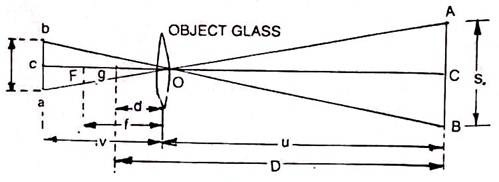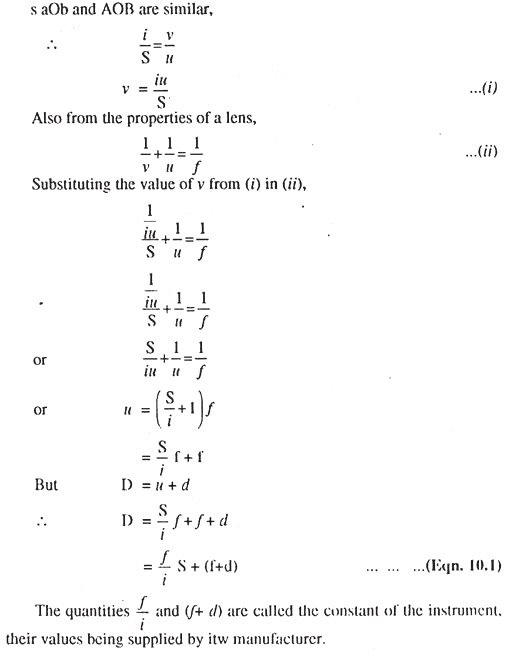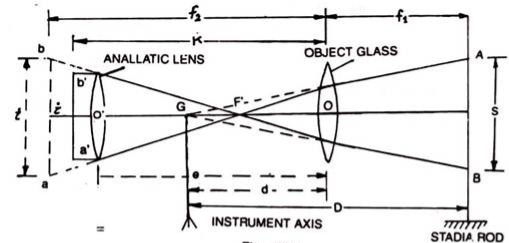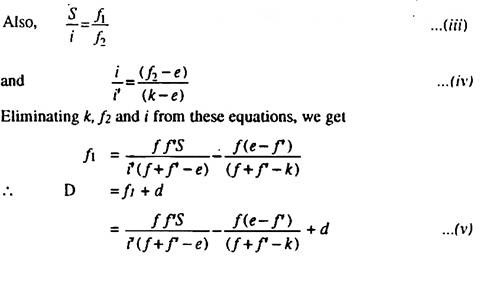SURVEY2
Unit -1Measurement of distances and elevations Q1) What are the working method of tacheometry levelling?A1) The underlying principle common to different methods of tacheometry is that horizontal distance between an instrument station and a point as well as the elevation of point relatively to the instrument can be determined from angle subtended at the instrument station by a known distance at point and vertical angle from instrument to the point. The various tacheometric methods employ principle in different ways and differ one another in methods of observation and reduction, but may be classified under two heads: (i) The stadia system. (ii) The tangential system. Q2) What are the basic principle of tacheometry levelling?A2) The underlying principle common to different methods of tacheometry is that horizontal distance between an instrument station and a point as well as the elevation of point relatively to the instrument can be determined from angle subtended at the instrument station by a known distance at point and vertical angle from instrument to the point. The various tacheometric methods employ principle in different ways and differ one another in methods of observation and reduction, but may be classified under two heads: (i) The stadia system. (ii) The tangential system. Q3) What are the equation for horizontal line of sight of tacheometry levelling?A3) The principle of stadia taceometry is explained as follows: (Fig.
Let O= the optical center of the object – glass a, b and c= the bottom , top and central hairs at diagram A,B and C= the points on the staff cut by three lines a b= i the interval between stadia lines. (ab is the length of the image of AB) AB=S=the staff intercept (the differences of the stadia hair readings) f= the focal length of object – glass i.e, the distance between the centre (O) to the principal focus (FG) of the lens. u – the horizontal distance from the optical centre (O) to the staff. v = the horizontal distance from the optical centre (O) to the image of the staff, u and v being called the conjugate focal length of the lens. d = the horizontal distance form optical centre (O) to the vertical axis of the taceometer. D = the horizontal distance from the vertical axis of the instrument to the staff,
The constant f/i is called the multiple constant and its value is usually 100, while constant (f+d) is called the additive constant and its value varies from 30 cm to 60 cm in case of external focussing telescope, it is very small varying from 10 cm to 20 cm and is therefore oftenly ignored. To make value of additive constant zero, an additional convex lens, known as anallatic lens, is provided in the telescope between the object – glass and eye piece at a fixed distance from former. By this arrangement, calculation work is reduced considerably. The equation is applicable only when the line of sight is horizontal and staff is held vertical. Q4) What is contour and characteristic of contourA4) ContoursContour is a line joining the points of equal elevation.Characteristic of ContourContours show distinct characteristic features of the terrain as follows: i) All points on a contour line are of the same elevation. ii) No two contour lines can meet or cross each other except in the rare case of an overhangingverticalcliff
iv) Widely spaced contour lines indicate gentle slope v) Equally spaced contour lines indicate uniform slope vi) Closed contour lines with higher elevation towards the centre indicate hills vii) Closed contour lines with reducing levels towards the centre indicate pond or other depression. viii) Contour lines of ridge show higher eleva tion within the loop of the contours. Contour lines cross ridge at right anglesMethods of Contour SurveyingThere are two methods of contour surveying:Direct method Indirect method Q5) Explain substance bar? A5) A subtense bar (fig. is a horizontal staff with targets fixed at a known distance apart. It is about 4m long having a small spirit level and a quick levelling head. A sight rule, provided at its centre, can be placed along line of sight by viewing the telescope of the theodolite thought the vanes. The bar is mounted on a tripod and is placed at right angles to line of sight for making observations. After levelling and aligning, it is clamped by means of clamp screw. The targets, made of discs of about 20 cm diameter are painted red on one side, and white on the other. The centres of body sides of the targets are painted black in 7.5 cm diameter. The targets are placed at a distance of 2.5 m and 3 m. When targets are placed 2.5 m apart, the white faces are to face instrument and when they are placed 3m apart, the red faces face instrumentQ6) What is contour in tacheometry levelling?A6) Tacheometric method is adopted for contouring of very steep hills. i) Set up the tacheometer at the top of the steep hill. Tacheometer is a theodolite fitted with stadia diaphragm. The stadia diaphragm has three horizontal parallel hairs instead of one as found in a conventional cross hair diaphragm. ii)With the help of a tachometer it is possible to determine the horizontal distance of the point from the telescope as well its vertical level.
iii) The steep hill is surveyed at three levels – the base of the hill, the mid-level of the hill and the top level of the hill. iv) Using the tachometer reading are taken all around the hill at equal angular intervals on these all 3 levelsv) The radial plot thus obtained is worked in the office to interpolate points of equal elevation for contour mapping. Q7) Write stadia reduction formulas?A7) In stadia work we are concerned with finding two values as follows: (1) horizontal distance from center of instrument to the stadia rod and (2) vertical distance, or difference in elevation, between the center of instrument and middle-hair reading on rod. To obtain these values, you must use stadia reduction formulas. Stadia Formula for Horizontal Sights. — For a horizontal sight, distance that we need to determine is the horizontal distance between center of the instrument and stadia rod. This distance is found by adding the stadia distance to instrument constant as follows: Write ks for the stadia distance and (f + c) for instrument constant. Then the formula for computing horizontal distances when sights are horizontal becomes the following:H=ks +(f+c) Where: h = horizontal distance from the centre of the instrument to a vertical stadia rod k = stadia constant, usually 100 s = stadia interval f + c = instrument constant (zero for internally focusing telescopes; approximately 1 foot for externally focusing telescopes) f = focal lengths of the lens c = distance from the center of the instrument to the center of the lens Q8) Explain anallatic lens in external focusing telecscope?A8) An additional convex lens, called an anallatic lens, is provided in external focussing telescope between the eye — piece and object — glass at a fixed distance from the later, to eliminate the additive constant, (f+d), from the distance formula:
In order to simplify the calculation work. The anallatic lens is seldom placed in internal focussing telescope since the value of additive constant is only a few centimeters and can be neglected. The disadvantage of the anallatic a lens is reduction in brilliancy of the image due to increase observation of light.The value of the additive constant, (δ+d) can be made equal to zero by bringing the apex (G) of taceometric angle AGB (Fig. 10. 4) into exact coincidence with the centre on\f the insrument. The theory of anallatic lens is explained ad follows: In fig. GIVEN BELOW
Let, S = the staff intercept AB. i = the length b a of the image of AB i.e. the actual stadia interval when anallatic lens is interposed. i = the length ba of the image of AB when no anallatic lens was provided. O = the optical centre of the object – glass. O = the optical centre of the anallatic lens e = the distance between the optical centre of the object glass and the anallatic lens. f = to cel length of object glass. f’ = focal length of the anallatic lens. F = Principle focus of the anallatic lens. G = the centre of the instrument. d = the distance from the centre of the object — glass top the vertical axis of the instrument. D – the distance from the vertical axis of the instrument to the staff. f1and f2 = the conjugate focal length of the object —glass.k = the distance from the optical centre of the object glass to the actual image b a.(k— e) and (f2 —e) = the conjugate focal length of the anallatic lens.The ray of light from A and B are refracted by the object — glass to meet at F. The anallatic lens is so placed that F is its principal focus. Thus ray of light would become parallel to the axis of the telescope after passing through the anallatic lens and give actual image b a of the staff intercept AB.
The negative sign is used in (ii) since b ‘a’ and ba are on the same side of the anallatic lengs.
now the conditions that D should be proportional to S requires that the 2nd and 3rd terms in (v) are equal to zero so that
In this condition, the apex G of the tacheomeric angle AGB exactly coincides with the instruments
In this condition, the apex G of the tacheomeric angle AGB exactly coincides with the instruments
Q9) Explain levelling by stadia?A9) Levelling by stadia tacheometry is an indirect and rapid method of levelling. It is suitable where country is rough and precision needed is not great. The transit should preferably be provided with a sensitive control level for vertical vernier so that error may be readily eliminated. The method of running a line of levels by this method is as follows: (i) Set up transit at a convenient point. (ii) Take a back sight on staff held at a B.M., first by observing stadia interval and then by measuring vertical angle to some arbitrarily chosen mark on the staff. (iii) Establish a change point in advance of transit, and take similar observations, the vertical angle being measured with horizontal cross-hari set on same mark as before. (iv) Move trait to a new point in advance of change point and repeat the process. (v) Record stadia distance and vertical angles and also staff reading which is used as an index when vertical angles are measuredQ10) what is fixed hair and moveable method in tacheometry levelling?A10) (i) Fixed Hair Method: In this method, distance between the stadia hairs is fixed. When a staff is sighted through the telescope, its certain length is intercepted by stadia hair and from tins value of staff intercept, the distance from instrument to the staff can be determined. The staff intercept varies with its distance from instrument. This method is most commonly used in tacheometry. (ii) Moveable Hair Method: In this methods, stadia hair are not fixed but can be moved by means of micrometer screws. The stall is provided with two vanes or targets fixed at a known distance apart. The variable stadia distance is measured, and from this value required horizontal distance may be found out. The method is now rarely used.
iv) Widely spaced contour lines indicate gentle slope v) Equally spaced contour lines indicate uniform slope vi) Closed contour lines with higher elevation towards the centre indicate hills vii) Closed contour lines with reducing levels towards the centre indicate pond or other depression. viii) Contour lines of ridge show higher eleva tion within the loop of the contours. Contour lines cross ridge at right anglesMethods of Contour SurveyingThere are two methods of contour surveying:
iii) The steep hill is surveyed at three levels – the base of the hill, the mid-level of the hill and the top level of the hill. iv) Using the tachometer reading are taken all around the hill at equal angular intervals on these all 3 levelsv) The radial plot thus obtained is worked in the office to interpolate points of equal elevation for contour mapping. Q7) Write stadia reduction formulas?A7) In stadia work we are concerned with finding two values as follows: (1) horizontal distance from center of instrument to the stadia rod and (2) vertical distance, or difference in elevation, between the center of instrument and middle-hair reading on rod. To obtain these values, you must use stadia reduction formulas. Stadia Formula for Horizontal Sights. — For a horizontal sight, distance that we need to determine is the horizontal distance between center of the instrument and stadia rod. This distance is found by adding the stadia distance to instrument constant as follows: Write ks for the stadia distance and (f + c) for instrument constant. Then the formula for computing horizontal distances when sights are horizontal becomes the following:H=ks +(f+c) Where: h = horizontal distance from the centre of the instrument to a vertical stadia rod k = stadia constant, usually 100 s = stadia interval f + c = instrument constant (zero for internally focusing telescopes; approximately 1 foot for externally focusing telescopes) f = focal lengths of the lens c = distance from the center of the instrument to the center of the lens Q8) Explain anallatic lens in external focusing telecscope?A8) An additional convex lens, called an anallatic lens, is provided in external focussing telescope between the eye — piece and object — glass at a fixed distance from the later, to eliminate the additive constant, (f+d), from the distance formula:
0 matching results found








